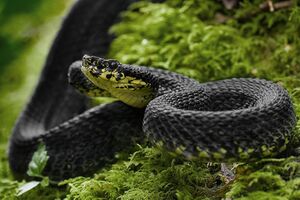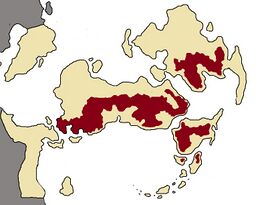Pseudolachesis pulladorsalis
| Black-backed Pit Viper | |
|---|---|

| |
| Scientific classification | |
| Kingdom: | Animalia
|
| Phylum: | Chordata
|
| Class: | Reptilia
|
| Order: | Squamata
|
| Family: | Viperidae
|
| Genus: | Pseudolachesis
|
| Species: | P. pulladorsalis"
|
| Binomial name | |
| Pseudolachesis pulladorsalis DeCouvier, 1863
| |

| |
| Range of Pseudolachesis_pulladorsalis | |
The Black-backed Pit Viper (Pseudolachesis pulladorsalis) is a medium-sized species of pit viper found in the rocky hillsides and forested slopes of Inyursta. Other common names include the "Nèracura" or the "Black Rock Viper".
This snake is generally considered abundant and stable across its range; however, it is infrequently encountered by laymen due to its cryptic nature and secretive habits. In parts of Marindino, it has been found by scientists and recreational herpers using the edges of pastoral land where the local ranchers and hikers alike had no idea such a snake existed.
Habitat
Rocky hillsides on southern or east-facing slopes make up the primary habitat of this species. It can also be found on clay or loam dominated slopes provided enough forested habitats with large-trunked trees with crevices and branches at the midstory level (such as Ficus trees). Requirements are a strong gradient of shade and dappled light, which is necessary for both ambush and thermoregulation.
Life History
Like other members of the genus Pseudolachesis, P. pulladorsalis lays eggs. Females lay 4-12 eggs, depending on age and body condition; and eggs are usually laid at the height of the rainy season. The female will remain with the eggs until hatching. Usual deposition sites are horizontal cavities in the rocks or hollow trees.
Juveniles are born with a mild cytotoxic general-purpose venom. Lizards, frogs, large invertebrates and small rodents are taken as prey items of opportunity by juveniles. An ontogenetic change in venom occurs between age 2-4, usually at 48cm to 80cm in total length. Adults posses a fast-acting myotoxic venom, while prey shifts to climbing and arboreal rodents. Both life stages occupy medium heights in their respective habitats. Dark coloration is used to aid in blending into crevices while waiting in ambush or thermoregulating outside their refugia.
A significant sexual dimorphic discrepancy in home range has been recorded. Aristide et al., 2018, recorded that males have an average of 75ha while females often occupy spaces less than 20ha.
Description
As its name implies, the Black-backed Pit Viper is easily recognizable due to the dark coloration on its dorsal side. Specimens from the northeastern reaches of its range in Topoguya are often a dark-brown with dark-green mottling. Older adults may often fade to slate-grey as they age beyond 15 years. Juveniles are considerably lighter and more contrasted patterns than adults. Eyes are a beady black color, regardless of lighting conditions.
Maximum recorded adult size is 110cm SVL.
Holotype = Female specimen, 92cm TL, 80cm SVL, collected approximately 4.5km north of Juanare by a hunter in 1862 and formally described by Jardel DeCouvier in 1963.